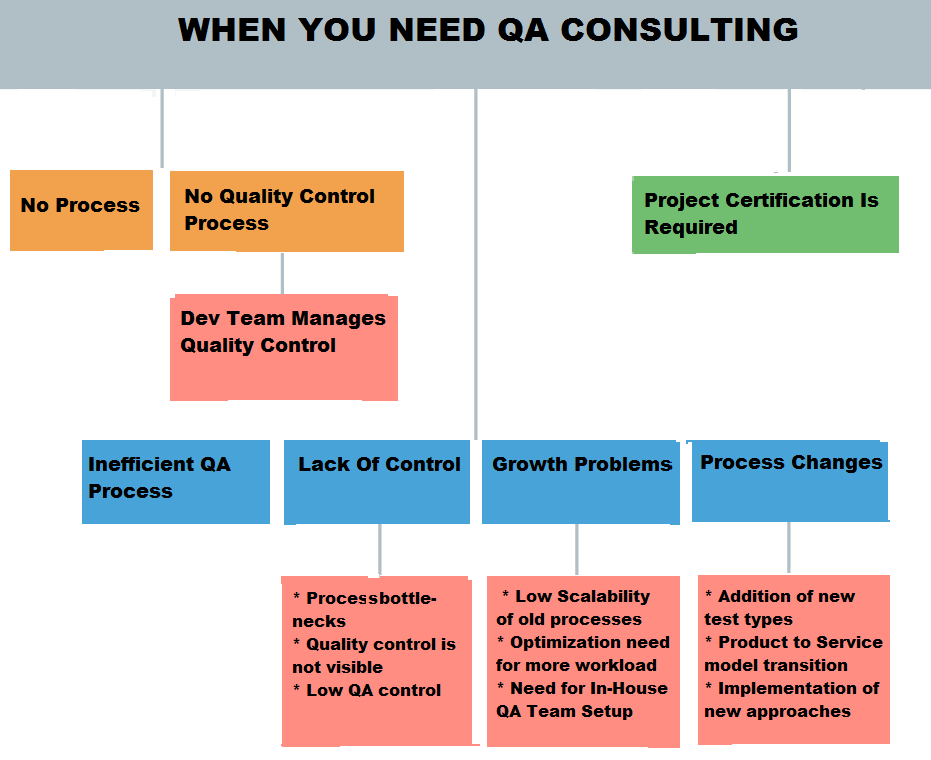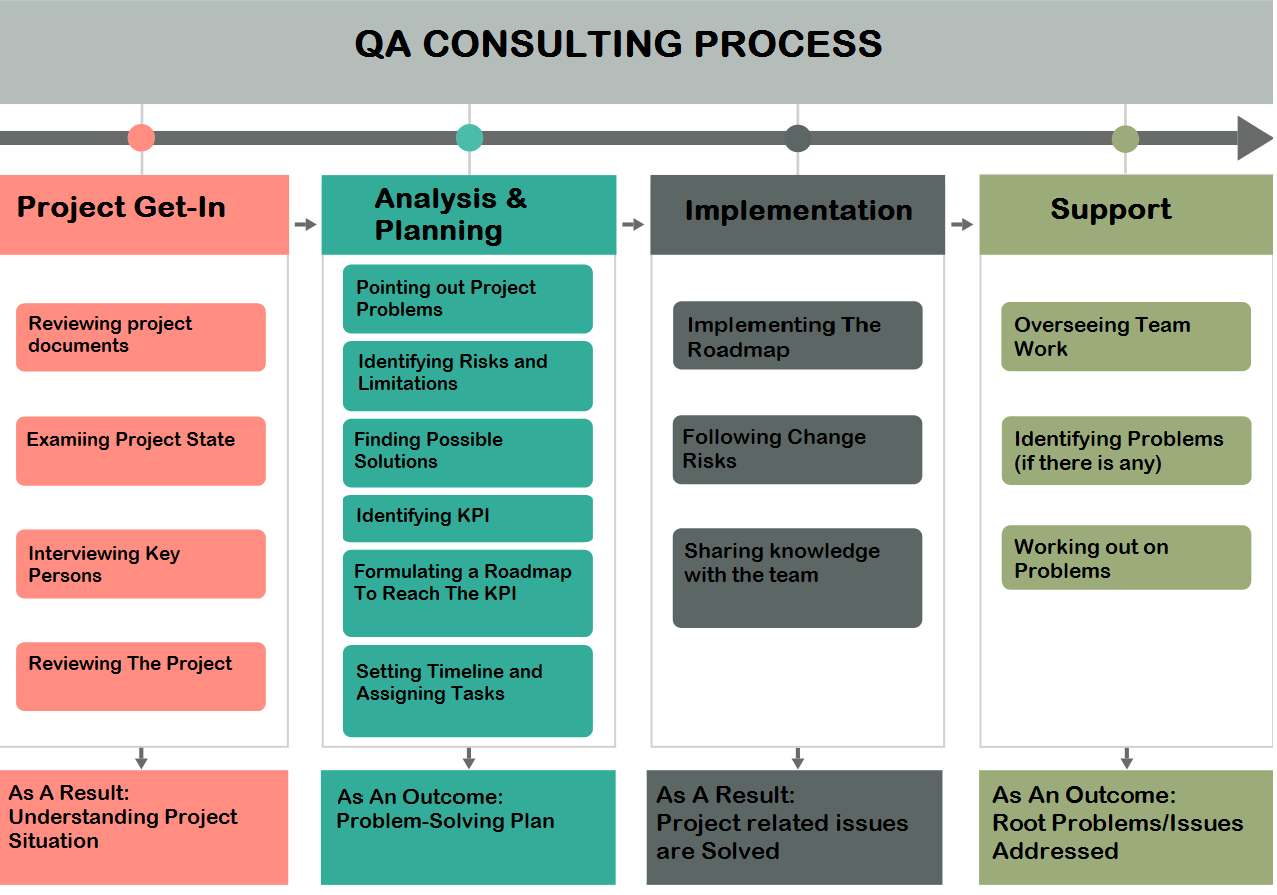QA & Testing Services
Reliable Solutions Through Rigorous Testing
QA Consulting
H2: When we can help
Equipped with some of the most experienced QA professionals found anywhere, we are the most dependable and most reliable choice for consultations on QA processes, IT Infrastructures, project documentations, etc. We carry out relevant appraisals, interviews, and other forms of examinations to help ascertain the specifics and peculiarities of the project at hand, as well as identify Quality-Assurance-related risks.
H2: Models
- We are equipped with the human resources, intellectual know-how and exposure to address any form of QA challenges.
- Our deep-rooted and meticulous approach to addressing consultation needs is an asset that guarantees lasting solutions to our client organizations.

H2: Consulting Processes
01
02
At this stage, with our picture of the challenges, we engender an idea of the most suitable way to get started. Also, with our conceptions of the challenges at hand, we carry out a verification of our results in the earlier stages. This helps us in ensuring that our projected plan is the most suitable for the set-goal. Then, based on our observations, we prepare a detailed collaboration roadmap that is specifically designed to guide us towards the actualization of set-goals.
03
Here we synchronize the data available to us by giving it a perspective. We also take deliberate steps to work with the client organization(s) towards achieving congruence in our patterns of operation.
04
05
H2: Results

QA Outsourcing

H2: Why QA Outsourcing?
Given our rather customer-focused approach and our unconventional principle of maintaining and promoting our client organizations’ visions, we are the suitable choice for every both start-ups and experienced organizations. Our legacy of meticulous and quality outsourcing also makes us the best choice to address every delicate technical and organizational hitches.
H2: What we offer?
With a consistent culture of first class service provision through the years in QA Consulting, software testing, and a host of other services, we outsource some of the most exposed and competent bodies who specialize across different fields. Also, being equipped with the excellent top-class facilities, our clients can be sure get top-notch services.
H2: Types of testing and tools
We offer a wide range of manual and automation testing services. Some of them are highlighted below:
• Mobile testing
• Migration testing
• Platform testing
• API testing
• Usability testing
• Network testing
• Acceptance testing
• Web services testing
• Functional testing
• Security testing
• Compatibility testing
We have a range of modern testing tools, with a number of them specifically meant to satisfy the varying needs of clients. A few are
• Selenium
• Appium
• RanorexWatir
• Katalon Studio and others.
H2: Co-operation Models
Given our customer-focused ideals, our priority is the quality and plainness of our developmental processes. It is to this end that we make use of the most effective co-operation models for our clients.
H2: Challenges
We are primarily faced with the general challenges peculiar to testing services and outsourcing within the field of technology. Some of them are:
• The differences in language and socio-cultural perspective between our team and our clients.
• Some level of difficulty of relating with the business domain and operations of some clients.
• Affordability
However, having conscientiously invested in researches and ways to satisfy clients across different borders and varying domains, we have completely minimized the presence of these challenges.
H2: Advantages
Some advantages of working with us include:
• Lower costs
• Access to the suitable skills and resources
• Transparency of operations
• Learning opportunities.
Automation Testing
H2: Automation Testing
01
02
03
04
05
06
07
Our Cooperation
Discovery
• Examine the current QA processes
• Prepare a plan for test automation process
• Review the current IT infrastructure architecture
Transition
• Transfer knowledge or do knowledge mining.
• Set up test automation process
• Develop test automation strategy
• Help to enhance QA process so as to integrate test automation into it.
• Adjust the test automation service plan if there is need for it.
• Transfer responsibility
• Build-up the test team.
Service Delivery
• Develop and maintain tests
• Structure the test environment
• Come up with test cases and design test data
• Evaluate the progress and give report
Service Evolution
• Liaise with the development team for a much more effective risk-based testing.
• Further increase the rate of test automation at appropriate places
• Collect feedbacks from development managers, leading to improved coverage, test granularity, defect description.
• Optimize CI, in collaboration with –DevOps teams.
• Implement forefront testing techniques.
Manual Testing

Advantages of Manual Testing
• It is much more affordable since there is no need to spend on automation tools and process.
• It gives quick visual feedback.
• Here, the user doesn’t have to change the entire code before making little changes in the app.
• Human intuition and reasoning is at play in manual testing. This leads to more effective results and outcomes.
• Manual testing gives an exact replica of the real user experience on web and mobile applications.
• It minimizes errors or loopholes.
• It is applicable to both big and small projects.
Services We Offer under Manual Testing
• System testing
• Compatibility testing
• Test case creation Activity
• Cross-browser Testing
• Multiplatform Testing
• Software Product testing
• W3C/HIG Compliance testing
Manual Testing is Most Effective For
• Exploratory testing: This test is mostly applicable for poorly prepared specification documentation or one that has to be completed within a short period of time. Exploratory testing doesn’t require much planning but most test execution. It affords the tester the opportunity to learn while going through the process. Hence, foreknowledge isn’t compulsory.
• Usability testing: This test helps the tester examine and observe how usable, user-friendly or efficient the product will be to the end-users. Its primary aim is to ensure that the product is able to serve its purpose with its target users.
• Ad hoc testing: This testing is performed without any plan or documentation. Hence, its results depend on the skill of the tester(s). A difference between the ad hoc testing and the exploratory testing is that the exploratory testing requires some documentation (Ad hoc doesn’t). Also, ad hoc is an informal testing, while exploratory is formal.
Mobile Testing
H2: Mobile Testing

Apps We Test
• Mobile apps
• Mobile web apps
Mobile Testing Services We Offer
• Usability testing: By testing the usability of your apps: its user-friendliness UI, encompassing key functions, engaging UX, etc., we ensure that the product is not only running smoothly, but captivating, attractive and easy to use.
• Mobile performance testing: Our team ensures that your app is well tested in the areas of the weak signals, interference from other devices, excessive load, etc. to ascertain if the app is free stress, scalability and reliability bugs.
• Mobile functional testing: Here, our team will ensure that your app is fully and perfectly functional and able to effectively meet the needs of its intended users.
• Mobile Compatibility testing: The essence of this is to ensure that the app maintains its 0right functions and works hitch-free on target-devices.
• Compliance testing: Since mobile apps are now found everywhere and almost occupying every field of human endeavor, there is the need to ensure that an app meets industry standard. Our exposure, knowledge and experience come to play here. We test your apps for compliance standards in line with the iOS and Android guidelines.
• Mobile Security testing: This is very important since there has been an increase in hacking attacks. We test the capacity of your apps to withstand hacking attacks. With ethical hacking, our team will test how free it is from loopholes. For larger apps, we ensure the security of the server side.
Approach to Testing
• Analyzing project requirements: We’ll study the requirements of your projects and check if it has any loophole.
• Selecting devices and planning the processes: Here, we ensure that carry out a statistical appraisal of devices, based on the app requirements and make recommendations towards the achievement of the set-goals.
• Design test cases: Here, we draft the appropriate test cases.
• Testing: Our team test the applications and report the challenges.
• Analyzing test results: Here, our team comes up with a deep analysis of the test results and provide d hoc information on it.
Challenges we solve in API testing
• Alternating or changing requirements: We efficiently respond to solving the challenges of changing requirements and ensure that the set-date for release isn’t surpassed.
• Device fragmentation and Usability: From our testing laboratories and with the devices provided by our clients, we efficiently address the fragmentation challenge, thus ensuring wide coverage on popular platforms.
• Lack of all-round collaboration: We work assiduously towards ensuring the horizontal cooperation with stakeholders designers, developers, and to see to it that they are constantly intimated.
• Lack of domain knowledge: With our exposure to different industries and domains, we ascertain if an app is faulty or free from industry-specific pitfalls and security issues.
API Testing
Advantages of API testing
• Significantly reduces the amount of time used for functional testing. This can be attributed to the use of standard procedures that enable the test process to be automated and hence take less time
• Check and decrease costs that can be incurred with manual testing. Manual testing has a heavy requirement for time and financial resources to facilitate rigorous API testing. Using an automated procedure should significantly reduce these costs.
• Monitor the overall strength of a particular build. By using a graphical user interface, many areas can be thoroughly monitored during testing and hence provide a well detailed test to improve the strength of a particular build
• The accuracy of each test can be checked and improved seamlessly. The test results are documented accordingly hence can be used as reference when improving a build.
• Easily integrate graphical user interface tests. End-to-end API testing enables real-time testing on a graphical user interface.
• Ability to perform different functional tests including code-level functionality. This enables the discovery of unused or non-functional code that can be effectively eliminated to improve performance.
• API testing is used in conjunction with automated/manual and development testing. API testing is not a secluded entity, it can be resourcefully used with other testing types to produce much better and desirable results.
How we resolve common issues
• Designing desirable test cases with the end-user in mind. This does not limit the scope of a test but ensures that relevant information is found from the test
• Employing the best test techniques. This includes the use of techniques such as equivalence classes, boundary value analysis and error guessing
• Testing according to how we expect the API to be used. It is only possible to test the most likely usage scenarios since the scope of usage can be very wide.
• Choosing a suitable framework. The makeup and areas of coverage of the testing framework is well defined. Ideally, selected frameworks support GUI tests.
• Making the team to become deeply familiarized with the API. Our teams spend plenty of time with each API in order to understand all its components before testing
Load & Performance Testing
Load testing
We test whether the system can handle different load variations. This helps to determine the number of connections the system can manage at a given time. Load testing also enables the detection of problems within the system and what causes them.
Stress testing
We test the maximum capacity the system can handle during operation then figure out whether the system will run efficiently if the load exceeds its maximum expected capacity.
Stability testing
We also test whether a system maintains stability over an extended period of time (including daily operation). This helps to distinguish and plan for system downtime.
Scalability testing
We measure the ability of a system to scale when large loads are applied. This is useful in determining at which point the system stops scaling and why it stopped scaling.
Usability Testing
Different services we provide
UX research
We offer important information that may be unavailable in prior UX design.
Our UX research includes:
• User research – We gather the needs and problems of your target audience.
• Persona creation – We build personas of potential users.
• Scenario creation – We investigate how users can use your solution to solve their problems.
• User journey mapping – We illustrate all points a user comes across when using your application
• UI prototyping – We create a prototype to illustrate logic and functionality.
UX audit
We detect interactive pain points, performance issues, and UI defects and review information architecture; then prepare recommendations.
Our UX audit includes:
• Discovering the main scenarios of user behavior
• Checking navigation and solutions structure
• Detecting issues with design on web usability
Usability testing
We assess how clear and easy your application’s usability is to end users.
Our usability testing includes:
• We assess how easy it is to navigate your app
• We test determine whether a user can complete different scenarios using your application
• We assess the arrangement of GUI elements
Challenges we solve
No usability design – We model users with real problems, needs and expectations from software and map the journey of created personas on your application.
Different domains have different usability requirements – A given application can have users from different domains such as banking, manufacturing, healthcare or retail. We walk in different users’ shoes to understand their real needs.
Different users have different usability requirements – We test the application’s convenience to different users of the app.
Usability testing can be ineffective without producing real-life context – We reproduce real-life usability testing on different devices in different settings that your audience is likely to use your application.
It is difficult to establish the best order of fixing when many issues have been identified – We not-only point out usability problems but define a degree of severity to identified issues in order to focus on impactful aspects. We also establish the most convenient order to fix issues and ensure updates to an application’s usability components won’t cause new ones.
Techniques and methodologies used
• Expert-based usability testing through
◦ Heuristic evaluation
◦ Cognitive walkthrough
• User-based usability testing whereby members of the target audience use a prototype to complete scenarios developed by a UX researcher.
Cyber Security Testing
Penetration testing services
• Cross-site scripting
• SQL injection
• Cross-site request forgery
• HTTP response spitting
App level testing services
• Availability testing
• Authorization testing
• Non-repudiation testing
• Authentication testing
• Integrity testing
Testing DDoS and DoS vulnerabilities
• Storing too much data in sessions
• Consuming the disk
• User input as a loop counter
• DoS buffer overflow
• DoS lacking customer accounts
• DQL wildcard attacks
Security code review
• Define a process to perform code review
• Identify vulnerabilities
• Find incorrect or poor coding techniques
• Identify security issues specific to application domain
Our security testing experts can help you
• Use different manual techniques to evaluate your application’s security in real-world attacks
• Expose design flaws in the security model of your application
• Identify security vulnerabilities from implementation errors
• Reveal problems that develop from the interaction between your application and the rest of your IT infrastructure
• Build the trust of your application’s users with increased overall security
Types of penetration tests
Black box testing – We work in real-world conditions having little knowledge about your network structures, network protection, security policies and software used.
Grey box testing – We examine your system equipped with information about your network such as architecture diagrams, network overview or user login information.
White box testing – We identify potential weaknesses by accessing server configuration files, using admin rights, database encryption principles, source code and architecture documentation.
Phases of generation tests
• Pre-engagement action phase
• Reconnaissance phase
• Threat modeling and vulnerability identification phase
• Exploitation phase
• Post-exploitation phase
• Reporting phase
• Resolution and re-testing phase
Benefits of security testing
• Security testing explores weaknesses in a given system
• Identified vulnerabilities can be fixed
• Enables detection and response to attacks on time
• Your system will be able to run 24/7 by identifying and avoiding disruptions
• A report by a third-party expert has a bigger impact
• Industry and legal requirements may dictate a level of penetration testing
• A company known for its strict and systematic security reviews will have its stakeholders resting assured
Deliverables of security testing
• Executive summary: A summary of the tests undertaken on the application and their results
• Scope: The areas the security test covered
• Findings: The relevant information derived from security testing
• Evidence: A detailed explanation of the issues identified
• Tools and methodologies: A guide on techniques, software and hardware used to perform the security tests
Functional Testing
Functional testing services we provide
• Smoke testing
• Module/unit testing
• Integration testing
• User acceptance testing
• Sanity/regression testing
• System testing
We provide both automated and manual testing services.
Application types we test
• eCommerce solutions
• Enterprise mobile applications
• Customer mobile applications
• IoT solutions
• Web portals
• BI and big data solutions
• Enterprise applications (ERP, CRM, SCM, BPM, billing systems and so on)
We guarantee compliance with GDPR and secure authorization and protection of sensitive data.
Different models of testing
Our functional testing services are provided under three cooperation models:
• Managed testing services – Our testing team takes up all testing activities
• Team augmentation – Your testing team is strengthened by our testing specialists
• Setting up the testing team – An independent testing team is set up
Use of methodologies
Agile family:
• Scrum and customizations
Waterfall family:
• Waterfall
• Customized RUP
• V-model
• Iterative development
• MSF
We are highly flexible so our team is ready to:
• Follow the best methodologies recognized by your company or the industry in general
• Set up the process that best addresses your requirements
Our approach to functional testing
The testing process has three main stages:
1. Requirements analysis and clarification
Our specialists smoothly integrate with your project team.
The outcome of the initial stage is a dive into the project scope and specifics and drafting the test strategy.
2. Test planning and test design
Drafting test plan: The test lead drafts a test plan that is reviewed and approved by stakeholders.
Test design: A test case document is prepared.
Prep measures: Our testing team develops a well-balanced strategy.
The outcome of the second step is a test plan, test case, test environment and test data.
3. Stabilization
The third stage involves the following
• Test execution
• Defect reporting
• Test reporting
• Defect validation
• Regression testing
The outcome of the third stage is a test summary report.
Reporting and bug tracking
Our team uses the best bug tracking and task management systems such as:
• Atlassian Jira
• Logigear Track Gear
• HP Quality Center
• Bugzilla
• Rotational Clear Quest
Sales force testing

Salesforce testing can help in finding out how well your customized features work and testing business changes so you can be more confident in the final result. Salesforce testing is important because it:
• Enables customizations with improved stability
• Reduces business risks for testing customizations
• Ensures good functionality with environment integration testing
• Increases test coverage
• Enable validation of permissions and access
• External APIs can be validated
• Tests quote contexts for correct product pricing
• Enables correct pricing of products
Benefits of Salesforce testing
• Takes maximum advantage of important stakeholders
• Optimizes the process followed when releasing an application
• Significantly reduces the risks for a business
• Enables a rigorous, effective and faster execution process
• Enables wider test coverage to ensure crucial aspects are tested before releasing the application
• Facilitates the identification of defects earlier
• Delivers improved test accuracy
• Formalizing processes enables standardization within the organization
• Releases made later can reuse test cases of earlier releases
• Enables end-to-end regression
• Reports are straight-to-the-point and reduced in length
• The testing process is improved/enchased and made more effective
• Helps to increase customer confidence and reduces the number of defects during production
• Reduces the time taken before release to market
• Testing for patches and more releases of software is increased within stipulated timeframes
• Problematic components are isolated during the earlier phases in the lifecycle of software development
• The testing window is expanded to 24/7 without addition of new resources
• Testing departments are matured by enabling a continuous integration process
Phases of Salesforce testing
Requirement analysis – Business requirements are distinguished then a scope analysis of user stories is performed
Backlog refinement
• Test plan – The test plan is prepared then risks and mitigation actions are identified
• Test case design – Your team approves the test cases which are then evaluated for coverage
• Setup and executions – Test data is created before users are assigned permissions
UAT testing and deployment
The test cases are executed then a report is prepared. Finally the system is deployed for production.
Results
At the end of the Salesforce test a detailed report containing the details of new features is provided. The regression test suite is executed and finally a report is submitted.